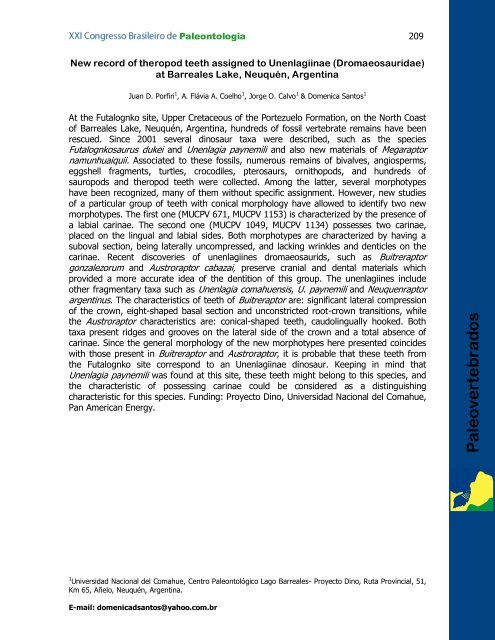Livro de Resumos - Dinossauros do Maranhão
Livro de Resumos - Dinossauros do Maranhão
Livro de Resumos - Dinossauros do Maranhão
You also want an ePaper? Increase the reach of your titles
YUMPU automatically turns print PDFs into web optimized ePapers that Google loves.
Paleontologia 209<br />
New record of theropod teeth assigned to Unenlagiinae (Dromaeosauridae)<br />
at Barreales Lake, Neuquén, Argentina<br />
1 Universidad Nacional <strong>de</strong>l Comahue, Centro Paleontológico Lago Barreales- Proyecto Dino, Ruta Provincial, 51,<br />
Km 65, Añelo, Neuquén, Argentina.<br />
Juan D. Porfiri 1 , A. Flávia A. Coelho 1 , Jorge O. Calvo 1 & Domenica Santos 1<br />
At the Futalognko site, Upper Cretaceous of the Portezuelo Formation, on the North Coast<br />
of Barreales Lake, Neuquén, Argentina, hundreds of fossil vertebrate remains have been<br />
rescued. Since 2001 several dinosaur taxa were <strong>de</strong>scribed, such as the species<br />
Futalognkosaurus dukei and Unenlagia paynemili and also new materials of Megaraptor<br />
namunhuaiquii. Associated to these fossils, numerous remains of bivalves, angiosperms,<br />
eggshell fragments, turtles, crocodiles, pterosaurs, ornithopods, and hundreds of<br />
sauropods and theropod teeth were collected. Among the latter, several morphotypes<br />
have been recognized, many of them without specific assignment. However, new studies<br />
of a particular group of teeth with conical morphology have allowed to i<strong>de</strong>ntify two new<br />
morphotypes. The first one (MUCPV 671, MUCPV 1153) is characterized by the presence of<br />
a labial carinae. The second one (MUCPV 1049, MUCPV 1134) possesses two carinae,<br />
placed on the lingual and labial si<strong>de</strong>s. Both morphotypes are characterized by having a<br />
suboval section, being laterally uncompressed, and lacking wrinkles and <strong>de</strong>nticles on the<br />
carinae. Recent discoveries of unenlagiines dromaeosaurids, such as Buitreraptor<br />
gonzalezorum and Austroraptor cabazai, preserve cranial and <strong>de</strong>ntal materials which<br />
provi<strong>de</strong>d a more accurate i<strong>de</strong>a of the <strong>de</strong>ntition of this group. The unenlagiines inclu<strong>de</strong><br />
other fragmentary taxa such as Unenlagia comahuensis, U. paynemili and Neuquenraptor<br />
argentinus. The characteristics of teeth of Buitreraptor are: significant lateral compression<br />
of the crown, eight-shaped basal section and unconstricted root-crown transitions, while<br />
the Austroraptor characteristics are: conical-shaped teeth, cau<strong>do</strong>lingually hooked. Both<br />
taxa present ridges and grooves on the lateral si<strong>de</strong> of the crown and a total absence of<br />
carinae. Since the general morphology of the new morphotypes here presented coinci<strong>de</strong>s<br />
with those present in Buitreraptor and Austroraptor, it is probable that these teeth from<br />
the Futalognko site correspond to an Unenlagiinae dinosaur. Keeping in mind that<br />
Unenlagia paynemili was found at this site, these teeth might belong to this species, and<br />
the characteristic of possessing carinae could be consi<strong>de</strong>red as a distinguishing<br />
characteristic for this species. Funding: Proyecto Dino, Universidad Nacional <strong>de</strong>l Comahue,<br />
Pan American Energy.<br />
E-mail: <strong>do</strong>menicadsantos@yahoo.com.br<br />
Paleovertebra<strong>do</strong>s


